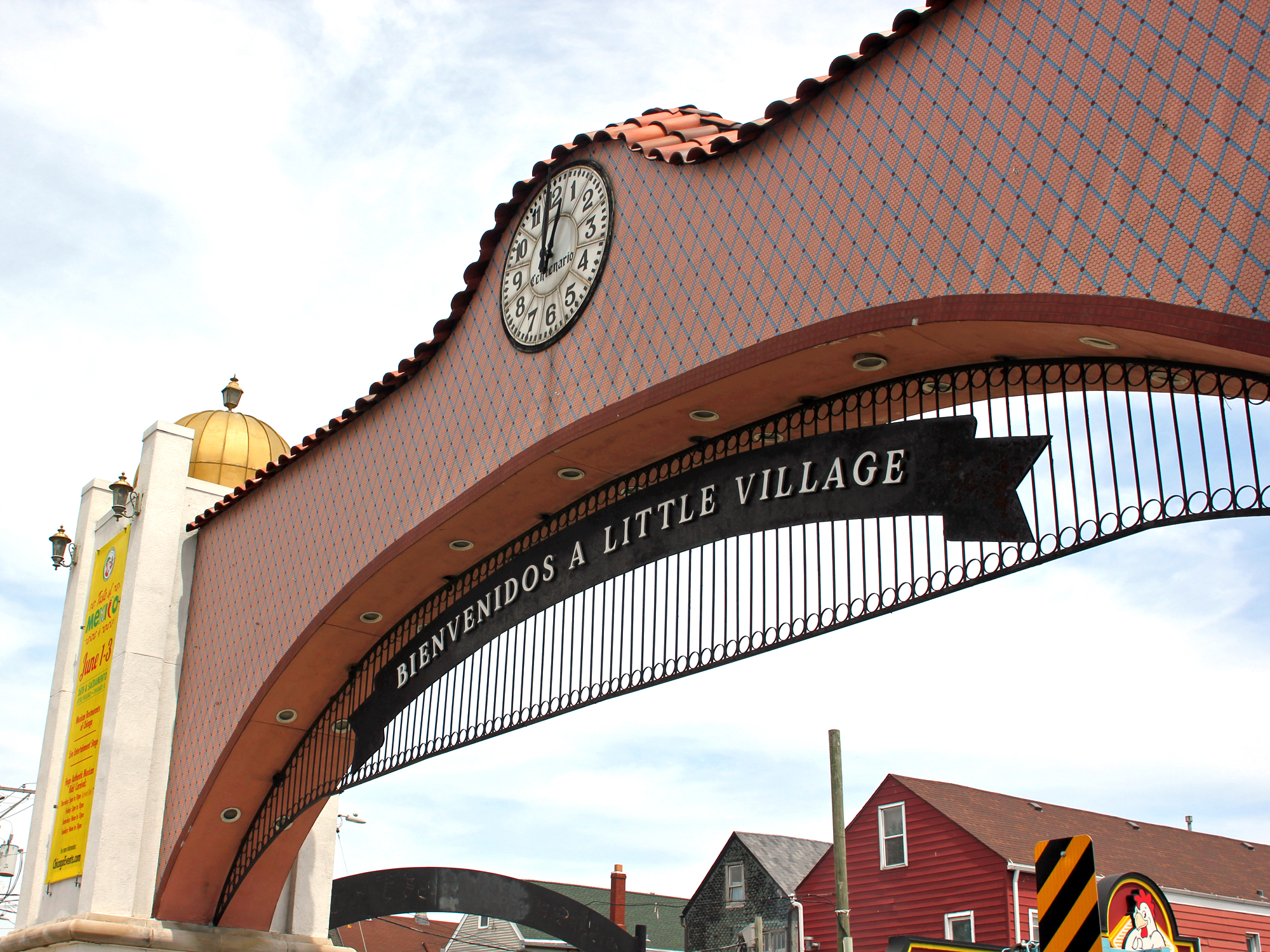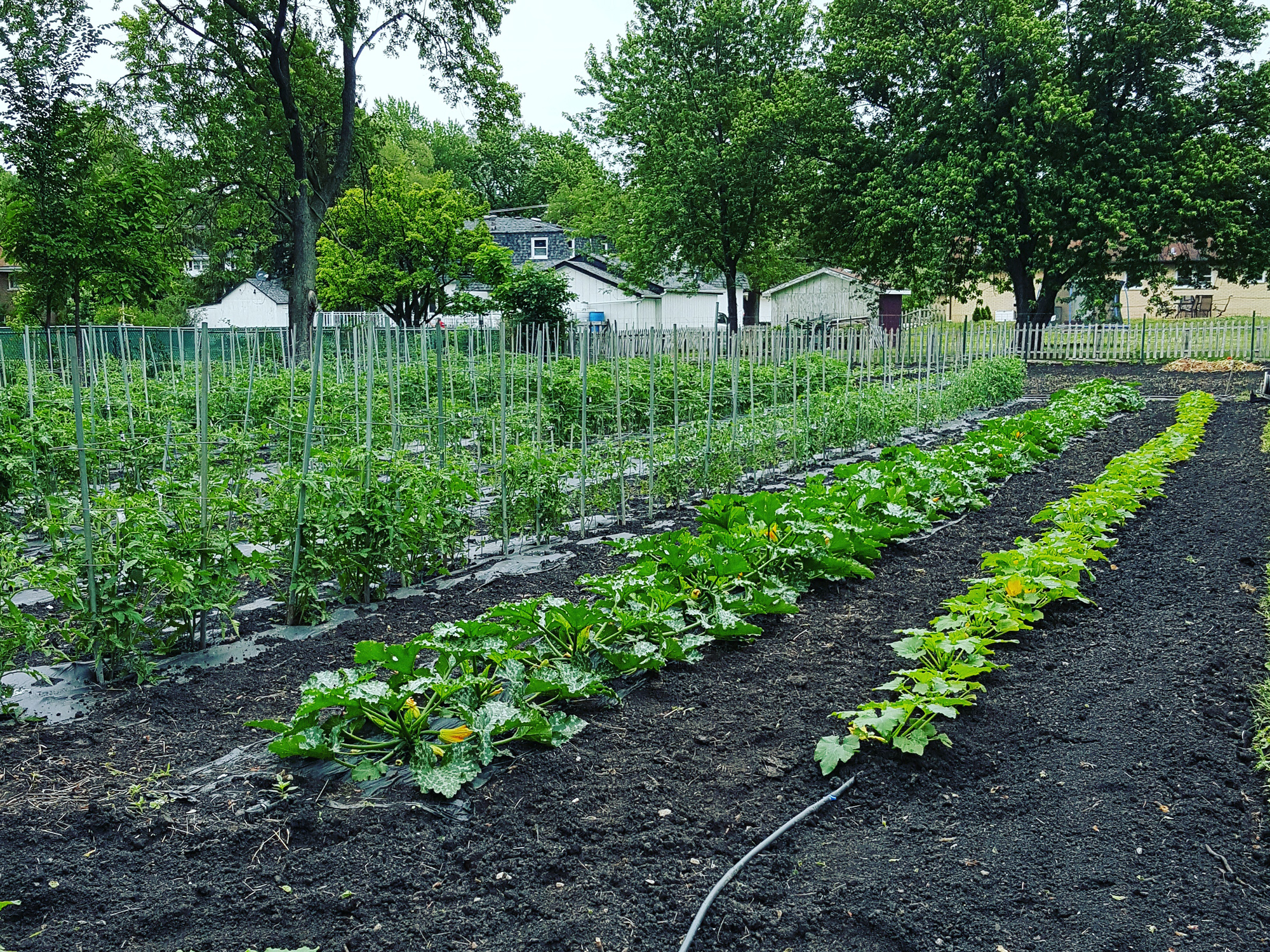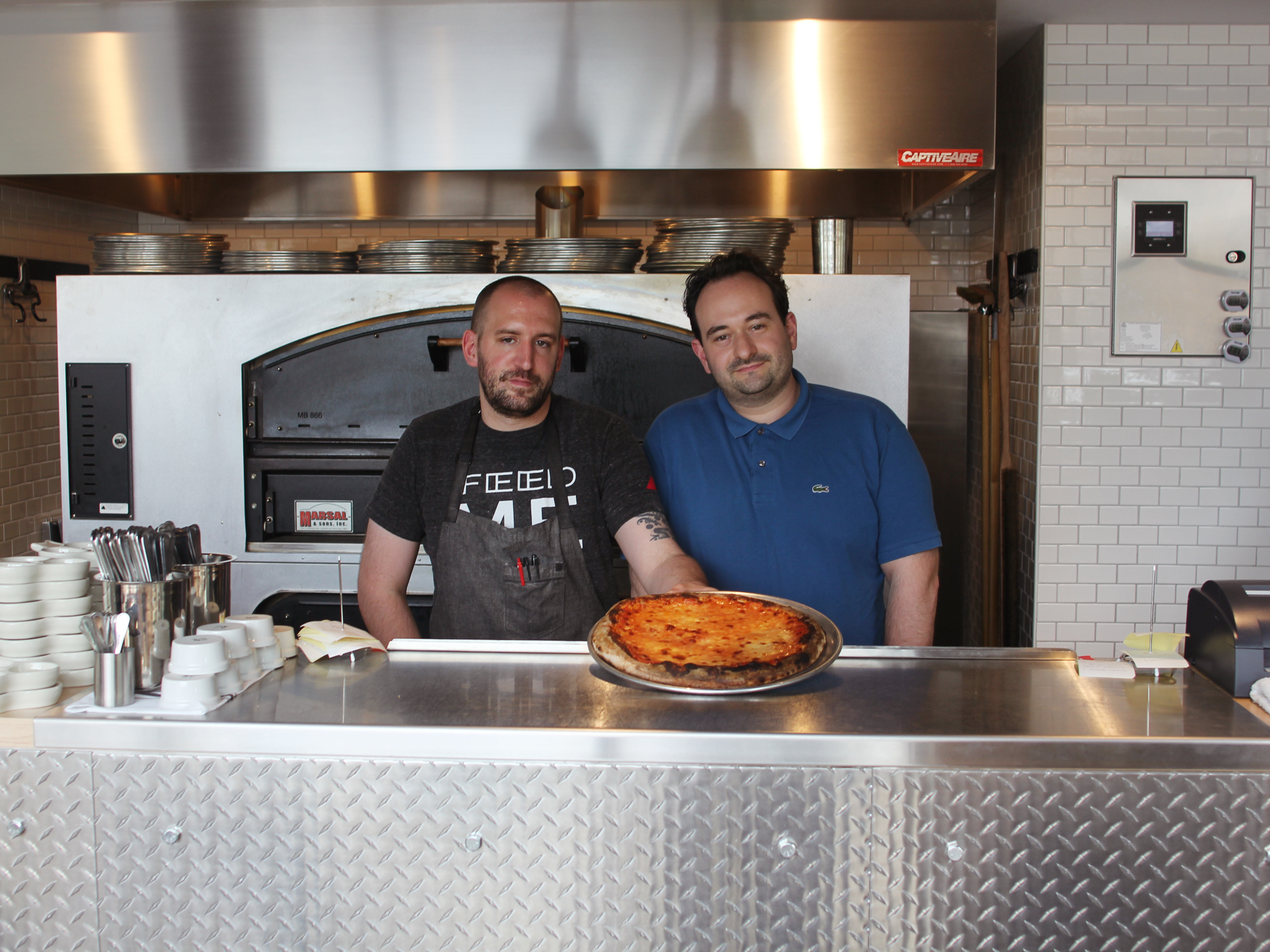WHEN I ASK ABOUT THE SECRETS OF HIS dough recipe, Ryan Gleeson seems to wince a bit. Before I can apologize for my apparent faux pas, he says that he doesn’t believe in secrets, and proceeds to explain every detail of his dough—from the decision to use sourdough, to how much water he uses, and his choice of bread flour rather than the “00” preferred by Neapolitan purists.
The result is a pizza with visible, open bubbles on the bottom of the crust, which is spongy without being doughy, not quite crisp. It’s closer to Neapolitan than anything, but with generous use of toppings and the aforementioned crust, it doesn’t quite fit the mold. Gleeson says that he’s making a sort of Indiana-style pizza, an improbable phrase that will begin to make sense after tasting his food.
Raised in Richmond, Indiana, Gleeson had the childhood that so often creates a cook: his mother is a first generation Italian-American, from a family of grocers who imported Italian produce. He wasn’t allowed to help his mother cook, but he’d sit and watch, taking mental notes of what he saw and bothering her with the occasional question. She made classic Italian food, even rolling out fresh pasta on occasion; she’s never been a pizza maker, but Gleeson points out that the same sorts of flavors are involved.
Gleeson started cooking during college, working through a handful of forgettable sandwich shops and starting to experiment with pizza in his free time. Was he a natural? Gleeson emphatically dispels the notion:
“We were just making really shitty pizzas, with just basic yeast, all purpose flour, let it rise for like ten minutes, throw it in and it’s just super dense,” he says. “And I dunno, I just have this really obsessive mind to make everything perfect, or I mean, not perfect… but I try to push myself as far as I can go with everything. I wanna answer like I’m still making bad pizza… I graduated a little bit.”
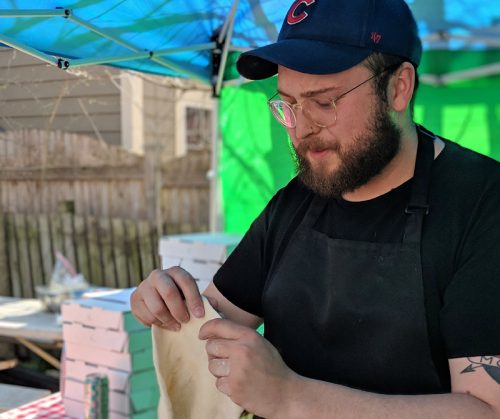 Joanna Lakatos
Joanna Lakatos Ryan Gleeson
A FEW FACTORS HELPED HIM TO GRADUATE to his current state. He bought a pizza oven (“On Craigslist—the guy was a total weirdo”), legendary Brooklyn pizzeria Roberta’s published their dough recipe, and he got a baking steel on which to prep the pies.
“I look at pizza and it’s 90% dough. The biggest thing in general has been switching to a sourdough,” he says, adding that the “magic” sourdough starter he uses is from Floriole in Lincoln Park. The flavor of the crust is further developed by a pronounced char that runs along the edges and covers much of the crust’s bottom. Gleeson uses a laser instant read thermometer to check on the gas powered Blackstone oven, waiting to throw in the dough until the temperature has reached 900 degrees Fahrenheit.
The thermometer confirms what we could already feel: the oven is face-meltingly hot. He throws one in and the spinning motion of the pizza stone pulls it into the heat, stretching the dough into an oblong shape. That oven has transformed his pizzas, though it’s seen better days: the stickers reading “CALL ME MAYBE” on its right side show the oven’s age, and Gleeson says it hasn’t been working perfectly ever since the stone cracked en route to an event. Dreaming of a new oven and trying to sell some tickets to his first pop-up, Gleeson put together an Indiegogo campaign with a goal of raising $750 in a month. He submitted the form, went to Costco, and arrived home to discover that the goal had already been reached.
He isn’t accustomed to the mass appeal of pizza. His last food endeavor was a vegan Cincinnati chili dog stand that he describes as “frustrating” for all parties.
Recounting the story, Gleeson sounds genuinely perplexed, pleasantly shocked. This seems to be his standard response: he responds to all compliments the way you would if a dog suddenly complimented your sweater. Having grown up in the DIY music scene of southern Indiana, Gleeson is used to small crowds and isn’t accustomed to the mass appeal of, say, the country’s most popular food. His last food endeavor was a “vegan Cincinnati chili dog stand” that he describes as “frustrating” for all parties. This pizza project has been different.
The mass appeal of the form is certainly part of it, but the pizzas get as weird as the diner allows. We start our meal with perhaps the most standard pizza there is: a margherita. From above it looks like many similar artisanal pizzas, but the long-fermenting crust leaves a lingering sour note that sets it apart.
Almost immediately the next pie comes out. This one is sauce-less, topped with pickled red onions, garlic, and rosemary. Gleeson credits the recipe to Phoenix pizza legend Chris Bianco, one of his pizza heroes, though he mentions developing his own pickle recipe, which has changed the final product a bit. If the margherita was a carbon copy meant to simply highlight the crust, this pizza is a cover of a modern classic, reinterpreted by the performer. Pickling has taken some edge off the onion, and the sweet, acidic flavor prevents the fatty monotony of cheesiness from setting in.
We finish with an extremely cheesy pie covered in spinach and a blizzard of cracked black pepper. While the second pizza was undeniably delicious, this last one, though just as good, is a bit puzzling. Is it a tribute to a childhood love for creamed spinach?
Gleeson begins a bit sheepishly, talking about his attempt to fuse Indiana cuisine with Italian cuisine. As he talks, he gains momentum, talking faster and becoming more enthusiastic as he explains the unique circumstances that shaped his view of cuisine, with his mother “so connected to her ancestral food and culture, but at the same time, in the middle of Evangelical and Quaker communities.” His family was a group of Italian Catholics that didn’t quite fit in, influencing and being influenced by their home state. Gleeson sees himself as an ambassador of sorts, cooking in a major city and trying to sneak bits of home into his cooking, to serve his native cuisine as something special and highly regional, not just as “elevated” drunk food with fancy ingredients.
“People think of Indiana food as just garbage,” Gleeson says. “But it’s homey things, like creamed spinach, creamed corn, pork cutlet sandwiches. For humor’s sake, I’d like to put it on a pizza.”
 Alice Feldt
Alice Feldt GLEESON’S IN THE MAGICAL STAGE RIGHT NOW: a day job still pays the bills and he’s beginning to get a bit of buzz. His pizzas are a hit, but he’s still cooking out of his house, personally engaging with every customer. There’s no commercial space with a lease and inspections, no Yelp reviews, profit and loss statements, or employees to manage. There’s playfulness and idealism, a restless energy to try anything that comes to mind with an indifference to the possibility of failure.
His home feels like the culinary equivalent of a DIY music venue—a bit rough around the edges and bursting with creative energy. Will it be possible to keep this feeling, for both Gleeson and the diner, if this grows into something bigger? Can a pizza shop truly be a community space? Can a cook make a living without the complications brought about by investors? Can cooking be balanced with something resembling an ordinary life?
With all of these questions piling up in my mind I ask him what the best-case scenario would be. “I’m wealthy.” From the pizza? “I find cash on the sidewalk and I give out pizza for free. Not having the stress of having to think about money—I could just keep doing a thing.”
He brings up Brooklyn’s Roberta’s, and how much he loved it in its early days, “Like a DIY punk venue, plus good food, and it worked.” Roberta’s did feel like a pizza punk utopia in its early days, but it didn’t stay that way for long. Recent years have seen infighting among Roberta’s initial partners, lawsuits, and tax trouble. They’ve also published a cookbook, opened a bakery, and sell their frozen pizzas at select Whole Foods stores. Growth, it seems, is never simple.
If I’m disproportionately focused on the distant future, it’s with good reason. Until last fall I was co-owner of a wholesale donut business. I’d started out a lot like Gleeson, frying donuts in my home kitchen, getting a chance to chat with every customer, and happily driving across town to deliver a dozen donuts.
When I got the opportunity to take on a partner, gaining access to a commercial kitchen and much needed capital, I was thrilled. Over the course of fifteen months I watched the business grow. Getting new business was easier than I’d imagined, but every new account seemed to bring a new headache. I struggled. Labor costs got out of control, hiring was difficult, equipment broke, some accounts were fickle. Growth meant I was busier and busier, but at the end of the month, the numbers remained unchanged, we could always just barely pay our bills.
There was no light at the end of the tunnel. I wasn’t sure what the light would look like anyway. What had once been so personal, such a passion, had become all about numbers, production and the balance sheet. I was making donuts but they might as well have been paperclips or tennis rackets. To borrow one of Gleeson’s favorite phrases, I no longer felt free to “get weird.” The magic was gone. It suddenly felt like I was running a factory.
The coming months will present many opportunities to “get weird” with pizza ideas. After the Indiegogo campaign exceeded expectations, a pop-up in Gleeson’s hometown of Richmond, Indiana was added to the two Chicago pop-ups. And then there’s Bar Danksylvania, a six-seat bar in Humboldt Park that does a variety of pop-up dinners with different guest chefs; when Gleeson is the chef, they serve three courses of his “pizza-esque” foods with cocktail pairings for a $30 suggested donation. All May dates sold out before they served their first dinner.
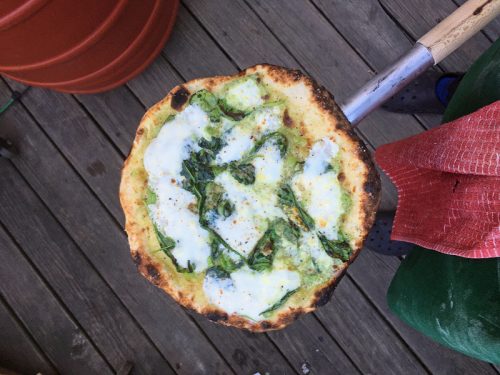 Ryan Gleeson
Ryan Gleeson THERE’S A LOT OF MOMENTUM AT THE MOMENT, but Gleeson doesn’t have concrete plans: “I’m just kinda on this ride right now where whatever happens happens,” he says. He’s been emailing back and forth with The Hatchery, learning a bit about his options for shared kitchen space.
When asked if he’d like to have a brick and mortar storefront space one day, he lights up and nearly yells, “I would love a place!” He’s quick to point out that he has no desire to build out a space in one of the city’s hip dining neighborhoods, hoping to find a unique space off the beaten path. Gleeson sees himself “repurposing something, fitting it in, and kinda forming a community around it. I can’t imagine a new construction. I like rules and having barriers. Taking over an old auto shop and turning it into something weird.”
It’s easy to imagine the various futures that could unfold. Gleeson could develop a project that fully realizes the dream of early Roberta’s. Or he could live out the actual fate of Roberta’s. Is it possible to keep it small, personal, idealistic and weird?
My curiosity isn’t just about his fate. After a few months away from the kitchen I co-founded Diaspora Dinners, a pop-up dinner series that explores the cuisines of the Jewish diaspora. So far it’s been great: small, intimate dinners, working alongside my wife and a few friends. It’s fun and fulfilling, but we are planning for it to grow, which is a bit nerve wracking. I’m eager to see if Gleeson can make the dream work. If he can, maybe I can, too.
This summer Gleeson will be doing the pop-ups with Bar Danksylvania and a handful of other ticketed pizza events in Chicago and Indiana. He’s hoping to participate in a few backyard barbecues in the neighborhood, and cook for some block parties. What will happen after the summer is anybody’s guess.
For now, if you happen to see a guy in East Garfield Park firing up a pizza oven, stop by and introduce yourself—he wants to make you a pizza. If you’re lucky, he’ll have found his fortune on the sidewalk, and it’ll be free. And in our dreams, it’ll stay like that forever.
Dylan Maysick is a Chicago-based cook and writer. He is the co-founder of Diaspora Dinners, a pop-up dinner series that explores the stories and cuisines of the Jewish diaspora.
Latest
Join the Discussion
After you comment, click Post. If you're not already logged in you will be asked to log in or register with Disqus.





